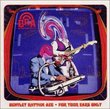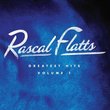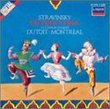| All Artists: Sibelius, Toscanini, NBC Title: Symphony 2 Members Wishing: 0 Total Copies: 0 Label: RCA Release Date: 3/10/1992 Genre: Classical Styles: Forms & Genres, Theatrical, Incidental & Program Music, Symphonies Number of Discs: 1 SwapaCD Credits: 1 UPC: 090266029426 |
Search - Sibelius, Toscanini, NBC :: Symphony 2
 | Sibelius, Toscanini, NBC Symphony 2 Genre: Classical
|
CD DetailsSimilar CDs |
CD ReviewsAn Impassioned Sibelius Concert Not to be Missed! 10/05/1998 (5 out of 5 stars) "1940 was an exceptionally fine year for the NBC orchestra and its conductor Toscanini. At last the ensemble had begun to achieve the cohesion of a real symphony orchestra, the musicians having adjusted to each others' playing, the Maestro's directing style, and the acoustic of Studio 8-H. Even the engineering of the NBC broadcasts and recordings improved dramatically in 1940, as judged from the broadcast aircheck on this disk and others in the BMG series (especially the Stravinsky "Petruchka" excerpts in Vol. 28 of the Toscanini Collection.)The all-Sibelius program of 7 December 1940 is replicated in part here, using the recordings of works performed that had received the Maestro's blessings for commercial issue: the live Sibelius 2nd and "Pohjola's Daughter", the 27 August 1944 live "Swan of Tuonela", plus the addition of the 1952 commercial "Finlandia" in place of the 1940 concert's closer, "Lemminkainen's Return". That missing work had been given one of the most hair-raising readings one will ever hear. Luckily we DO have access to this spectacular performance: transcribed from acetate disks of nearly as high quality as the "official" RCA material, it is contained in the marvelous Dell'Arte compact disk "Toscanini Conducts Music by his Contemporaries" on CD DA 9020.The interpretation of the Second Symhony is broader and richer than the more driven version from 18 February 1939, on Dell'Arte CD DA 9091 in much coarser, tighter 8-H sound. But modern listeners who are used to, say, an expansive Karajan reading, may be shocked and disturbed by the clipped, aggressive nature of parts of this reading (especially the unrhetorical second movement.) When it was first issued commercially in 1967 for the Toscanini centennial, many critics and much of the public acclaimed this performance as an anodyne to the current view of Sibelius as a romantic tone-painter. In Toscanini's hands, the composer's work is as tightly constructed and strictly argued as a Haydn sonata. The sound quality of the Symphony is among the best ever achieved in Studio 8-H, being taken from high fidelity acetate 33.3 rpm transcription disks made in the control room. Yet the "Pohjola's Daughter" from the same program is even better: listen to the yearning, upward thrusting brass passages beginning about 3:15 into the track, or to the grumbling basses at about 5:15. On the old Victor LP set of the Sibelius works, the symphony was in very dull sound, with better quality for the tone poem. Here, in this new BMG transfer made from Library of Congress archival original master disks, the Symphony and Op. 49 tone poem are in clear, crisp, immediate fidelity, with audio overtones extending up to about 9 kHz.The engineering of the live broadcast of 1944 of the "Swan of Tuonela" artificially emphasizes the inner voices and soft passages of the music, owing to a closer mike placement and added amplification by the gain-rider. Yet, one has an unusual opportunity of examing the details of this affecting work as never before: most modern stereo recordings present a recessed and wide soundstage in natural dynamics and perspective, not a "podium eye view". Toscanini and his players wring the last amount of gravity in this 9:19 reading: compare the 8:49 rendition of Jaervi (BIS CD-294) or Ormandy's 9:03 (EMI 5 65176): those extra seconds taken by Toscanini help build the mystery and drama of the work.The very well-known 5 August 1952 commercial recording of "Finlandia", made in a resonant Carnegie Hall, presents Toscanini's "canned" emotion and intensity, as compared to the spontaneity of the great 18 February 1939 broadcast in poorer sound (once available on the obscure compact disk Memories HR 4169; I have heard only a tape of the WRVR retransmission of the 1960s.) But it is nice to have this esteemed recording of the early fifties in a transfer that is more realistic in spectrum and dynamics than older LP incarnations." Sibelius at the Speed of Light Interplanetary Funksmanship | Vanilla Suburbs, USA | 08/31/2002 (5 out of 5 stars) "There are those who would stay away from this disc because of the relative age of these recordings (the Second Symphony, Pohjola's Daughter and The Swan of Tuonela in the early 1940s, and the most recent - Finlandia - in 1952). With the exception of the Finlandia, most people would stay away from the other recordings on the grounds that they were pre-high fidelity. And they would be wrong. The reason why so many of the 78 records from the 1940s sound so primitive is not because they are pre-high fidelity. In fact, it was RCA's own Sarnoff Laboratories that developed the advancement of high fidelity, which set the standard for the motion picture industry. Hi-fi greatly made for more realistic soundtrack recording, with its increased dynamic range and widened frequency range that allowed for greater intermingling of music, sound effects and dialogue. Nonetheless, it met stiff resistance from the musicians' unions, who feared that using hi-fi on records would draw audiences away from the concert halls, and keep the public in their living rooms. These are among the few rare experimental hi-fidelity recordings made by RCA during the 1940s, but - due to the union contract - were never released to the general public as records. Housed in the collection of the Library of Congress for decades, they have now been painstakingly remastered by BMG as part of the Arturo Toscanini Collection on compact disc. The reason Sibelius' Second Symphony is one of my favourite pieces of all time is because two performances not only never sound alike, any two sound like different pieces of music altogether. Even this Toscanini interpretation comes across radically different from his 1938 recording with the BBC Symphony. The only thing in common between the two is tempo, and in his NBC recording - as with so many others - Toscanini here, too, defies common wisdom by getting faster the older he got, rather than slower, as do most other performers. From the opening chords, there is only one word that can describe Toscanini's reading of the lightning-quick first movement: driven. In the allegretto, there is so much going on, with the opening phrased simply and eloquently by a wind trio, echoed by the lower brass. This opening theme is broken down into separate strands which are stated and re-stated in a frenzied ostinato by various combinations of lower strings, brass and woodwinds to an imperceptibly quickening tempo. Finally, the incessant repetition of the theme grows to a fortissimo as the solo trumpet and timpani drive the theme to its climax over the pulse of the lower strings and the trill of the clarinets and oboes. All throughout Toscanini's performance, though, his quick tempi never add up to sloppy execution, as they do with lesser conductors. Brilliantly, Toscanini never loses the tight rein he has on the NBC, evidenced in the uniform strings and the tight woodwinds, despite driving them off the metronome. Nor does he sacrifice dynamics or the subtlety of Sibelius' orchestrations; solo instrumentalists as well as the various orchestral sections coalesce, merge, collide and separate with masterful facility, all the while never losing sight of the composer's powerful musical statement. In the second movement, Tempo andante, ma rubato, the NBC is as equally powerful and understated. Although Toscanini handles this at a tempo a shade too rapid for my liking, he maintains the integrity of the movement throughout. While not as reflective as, say, a performance by an Ormandy or Koussevitzky, Toscanini's rendering of this movement nonetheless comes across as suspenseful, moving and eloquent. The third movement (vivacissimo) and the Finale: Allegro moderato once again display the maestro's unique ability to handle such a difficult and enigmatic piece. While Toscanini's interpretation is majestic, it never comes across as self-consciously virtuosic. His reading of the symphony, as well as the NBC's nearly flawless playing (a squeak from a clarinet in the final bars of the finale suggests a split reed) are communicated with such naturalness and finality that leads one to think that "this is the way this symphony was meant to be heard." The two tone poems in the central part of the disc, Pohjola's Daughter (from the same concert as the Second Symphony) and The Swan of Tuonela (from an NBC broadcast of August 27, 1944) also establish Toscanini as a dedicated (if selective) Sibelian. Toscanini was never one to treat tone poems as mere "light classics," which is fortunate, given the dark and ethereal beauty of these two pieces. Through Toscanini's baton, the NBC brings to these pieces the sense of loneliness, delicacy, exaltation and sadness that the composer intended in these retellings of Finnish runic legends. The added emphasis that Toscanini places on the tremolo of the strings in The Swan of Tuonela shows Sibelius at his impressionistic best; you can almost hear the lapping of the water under the swan as he glides through the black river waters. The English horn is bittersweet and melancholic, and one can immediately sense the fragility and isolation of the swan. This excellent disc ends with Toscanini's rousing rendition of Finlandia (recorded August 5, 1952 in Carnegie Hall). Another of Toscanini's unique talents was to take a "war horse" such as this and play it with gusto, without making it sound hackneyed. The opening chords on the brass almost pounce out at you from the speakers. Although I prefer vinyl to what I consider to be tinny-sounding remasterings, this CD version of Toscanini's Finlandia has a full, vibrant sound which brings out nuances and subtleties, which are not quite as audible in the original LP release (from Toscanini Plays Your Favorites, RCA Victor Red Seal LM-1834). The low rasp of the bassoon and the thunderous timpani send chills right down my spine!" Spectacular Sibelius Robert E. Nylund | Ft. Wayne, Indiana United States | 03/04/2006 (5 out of 5 stars) "The Finnish composer Jean Sibelius (1865-1957) had a unique and very powerful style. Early on, he joined Europe's nationalist movement by writing works based on Finnish mythology. These early works were much more approachable and more in the romantic spirit. All four of the works included on this BMG compilation are from Sibelius' early years.
After the second symphony, Sibelius moved into a more intimate, more personal style; he also matured as a composer and wrote the most advanced music he would ever write, culminating with the symphonic poem "Tappiola" and the incidental music to Shakespeare's "The Tempest." By 1929, he quit composing and would never really explain why, other than suggesting that music was changing and he did not want to write works that would be considered old-fashioned nor embrace the more "modern" trends in music. Remarkably, Sibelius lived until September 1957, making him the longest-living major European composer in history. Toscanini was very selective in programming the music of Sibelius. What he did conduct was certainly always given his best attention and played with great power and drama. The listener of these performances will not be disappointed, even if the sound of the symphony, "Pohjola's Daughter," and "The Swan of Tuonela," are not full high fidelity. The second symphony is often called a "warhorse." It has become extremely familiar and it is often played with little care for the real drama and emotion that is present in its four movements. Interestingly, the third and fourth movements are joined together by a powerful bridge much in keeping with Beethoven's innovations in his fifth symphony. This 1940 concert performance, in NBC Studio 8-H, is extremely well-played throughout. One can compare this with EMI's excellent 1938 recording of the same music with Toscanini conducting the BBC Symphony in Queen's Hall. In both performances, Toscanini ensures that the string players excel in the lush writing. From the scherzo to the epic finale, the NBC musicians clearly play with their hearts, "singing," as the Maestro would have wanted. The second symphony and "Pohjola's Daughter" were both released for the first time in RCA Victor's 1967 centennial boxed set. It was amazing to hear a number of concert performances that had never been released. The symphony was a special treat, of course, and there was the fascinating tonal painting of the symphonic poem. It is very wonderful and enjoyable music, filled with almost magical qualities in this captivating performance. Much can be said for another symphonic poem, "The Swan of Tuonela," which features such a wonderful English horn solo throughout, along with more of Sibelius' wonderful writing for the strings. Sibelius loved the strings because he was himself a very competent violinist. "Finlandia" was Sibelius' first great work, composed in 1899 as Finland remained under Russian control and longed for independence (something that would have to wait until 1917). This powerful music, which culminates in a hymn-like tune, captivated the Finnish people and has been embraced by others for its patriotic fervor. The 1952 recording, from Carnegie Hall, is among the best ever recorded. " |

 Track Listings (7) - Disc #1
Track Listings (7) - Disc #1


